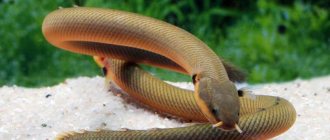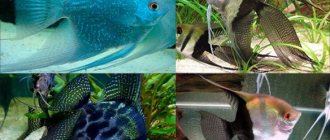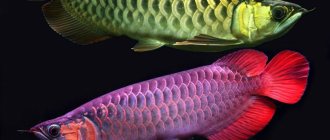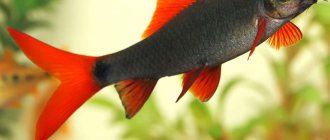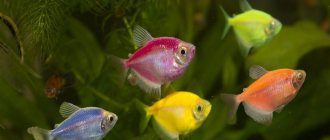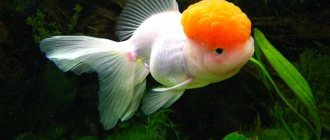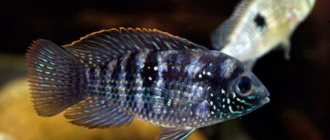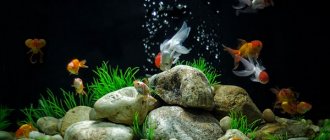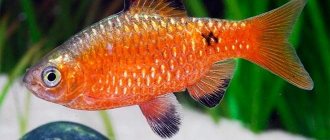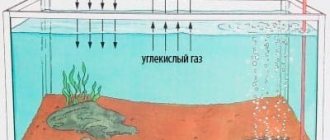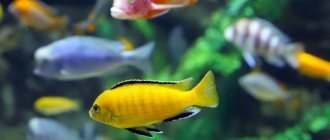Description
This is a large fish, it can reach 30 cm in nature, but in aquarium conditions it is about 15-20 cm. The larger the aquarium, the larger it will grow. Acara scales shimmer with a blue-green sheen, which is why they are called turquoise. There is a bright orange stripe on the dorsal and caudal fin. Males are larger than females, have bright turquoise scales, their distinctive feature is a growth on the forehead, the dorsal and anal fin are pointed. All the beauty of the fish is revealed in the males, because... females are not as bright and smaller in size than males. Females are also more aggressive, which is a feature of this fish, because In cichlids it's usually the other way around.
The Turquoise Acara is often called the "Green Terror" due to their tough temperament, which makes it difficult for them to be compatible with other fish. However, they differ in intelligence. They can recognize their owner, and if someone approaches the aquarium, they swim up to the glass to look at the person.
Motherland
Six species of the genus Aequidens, including the turquoise acara, were transferred to the genus Andinoacara in 2009. The first information about the ray-finned fish of the cichlid family was brought to the scientific community by the British-German ichthyologist Albert Gunther in 1860.
Cichlids, native to the north-west of Peru and Ecuador, are also found naturally in the river basins of Brazil, Colombia, and Venezuela. The fish were brought to the Soviet Union in the 70s. last century.
There is a hypothesis that modern Andinoacara rivulatus was bred artificially, since aquarium fish differ from wild specimens in their larger size and brighter color.
Under natural conditions, the turquoise acara lives in shallow rivers with dense vegetation that comes to the surface for shelter from herons. The fish feeds on larvae and adult insects, crustaceans and snails. The protein diet includes fry and small fish species.
Turquoise acara is a predator that forms pairs at sexual maturity (from 5–6 months).
The massive tall body of the cichlid is a classic elongated oval. The head is large with thick lips and gills decorated with greenish-blue curls. The scales of the fish are painted silver or green, tinged with turquoise. In the central part of the body there is a dark spot of a blurry shape.
Fatty growth is more pronounced in mature dominant individuals.
Rounded tail and pointed back fins - with white, scarlet or orange edging. Males are brighter and larger than females. The obvious difference is the fatty growth on the forehead.
Akara in nature
The historical homeland of cancer is considered to be reservoirs located in the northwestern part of Peru and the Rio Esmeraldas River basin. They are also found in South America, Central Colombia, Brazil and some other countries, preferring bodies of water without strong currents with rich vegetation and multiple shelters.
Cancers have been kept in aquariums since the seventies of the last century, and today they are one of the most sought-after cichlids among fish lovers.
Appearance
The colorful appearance is the main thing for which aquarists value turquoise acara. The main body color is silver-gray, with bluish-green dots located on most of the body. It seems that each scale is highlighted with a luminous halo. In the center of the body there is a dark spot of irregular shape. Turquoise wavy lines can be found on the gill covers and snout. The dorsal, rounded caudal and anal fins are also brightly colored and have a wide orange or white edge.
Turquoise acara is a very large cichlid; its size in an aquarium of suitable volume can reach 25-30 cm.
Mature males often develop a fatty growth in the frontal part.
Description of the fish
Turquoise acara (Аndinoacara rivulatus) is one of the most beautiful representatives of the cichlid family. It is impossible not to notice it in an aquarium. The fish has an expressive appearance, surprisingly bright colors and a unique character. Acara received its specific name for its color, since it means “stream” in Latin.
growing up to 30 cm in natural conditions body is covered with large scales that shimmer with a pearlescent sheen. Depending on gender and age, it either has a gray-green shine with rare blue sparkles in females and young people, or shines brightly with a greenish-blue, turquoise color in mature males.
This predator is perfectly camouflaged in its natural habitat. On the “face” and gill covers there are turquoise wavy stripes, iridescent colors, alternating spots and stripes work like special forces camouflage. Penetrated by thin rays of bright sunlight with alternating thick shadows, the fish “breaks into fragments” and disappears.
In the center of its body there is a dark spot of irregular shape, from a distance similar to the eye of a huge fish, and a bright orange stripe along the edge of the rounded caudal fin and along the upper edge of the dorsal fin form the “muzzle” of the giant. Thus, the turquoise acara scares away large predators.
It is not for nothing that this inconspicuous and aggressive predator is called the “blue horror” and “green terrorist”. It has been established that on an aggression scale from 1 to 100, the blue acara exhibits this character quality by 80 points.
Sloping with a steep forehead, the large head of the acara is decorated with wavy turquoise stripes located below the line of the large eyes. They give the fish's face a very conscious, attentive expression. The decoration of the head of males is a fatty growth on the forehead, which increases with age. In females it is much smaller or absent altogether.
The dorsal fin is wide and extends almost to the beginning of the tail. The pectoral fins have the same beautiful shape of a straightened round fan as the caudal fins. The large anal fin is triangular. Turquoise spots and dashes decorate all fins except the pectoral ones. The breasts are transparent with a slight saffron tint. The bright red-orange stripe along the edge of the fins may be paler, even whitish in fish with a pale color.
Kinds
For a long time, all cancers were classified in the genus Aequidens, but due to too many differences in species, after the 1986 revision they were divided into 5 genera: bujurquina, cleytracara, guianacara, crobia, letacara.
As for the species, there are more than thirty of them: Peruvian, spotted, turquoise, red-breasted, blue, silver, black-striped and others, there is no point in listing them all. Let's look at a few of the most popular ones:
- The bluish-spotted acara naturally lives in water bodies of Panama and Colombia, preferring those where the current is slow or absent. It appeared in Russia in 1910.
Its body size in captivity does not exceed 6-8 cm. The fish is colored in grayish-brown tones. There are many spots: oblong dark ones across the body, black in the tail area, shiny bluish-green throughout the body. The fin on the back is dark blue with a red border. This species is peaceful and can be kept with other fish. - Acara Meri is common in South America and lives in the reservoirs of its northern part. In an aquarium it does not grow more than 12 cm in length. The body color is olive-silver with a dark back and a light belly. All fins are red, except for the dorsal one (it is sea green). The iris of the eyes is golden yellow. There is a dark stripe running from the eye to the tail. The entire body is decorated with shiny blue spots and strokes.
- Acara Paraguayan lives in the very center of South America. This yellowish-brown fish can grow up to 12 cm. The entire body, including the fins, is covered with shiny green spots, and there are dark stripes on the sides. In small aquariums, Paraguayan acara become aggressive even towards their fellows.
Description and characteristics
The Turquoise Acara is a popular cichlid kept in home aquariums. This is due to the fact that it is relatively unpretentious compared to other species, but the fish is very beautiful and is easy to get on sale.
Akara turquoise also known as Green Terror
Why is it called that?
The official name of this original fish is Andinoacara rivulatus. The fish belongs to the cichlid genus. Turquoise got its name due to the bright shiny scales that cover its entire body. Moreover, in the light, the acara scales shimmer with the most specific shades, which gives it incredible beauty and radiance. Aquarists love to place such fish in their aquarium, as they can be watched for hours.
Interesting fact!
The colloquial name for this fish is “Green Terrorist”. This is due to the bright shade of the fish and its aggressive nature.
Appearance and photo
Perhaps the bright and catchy appearance of this fish is the main thing that attracts aquarists to it. The entire surface of the acara in the photo is covered with turquoise scales, which have different shades.
The body itself has a silver-gray tint, with dark blue dots scattered throughout it, which change their color depending on the light. Because of this, the scales of the fish look as if they are glowing from within.
The size of the fish is large - it reaches from 20 to 30 cm. On the front of the fish there are wavy turquoise streaks. The back, rear and lower fins are shiny blue with white or yellow edging. A distinctive feature of males is a fatty growth on the forehead.
Habitat
In its natural habitat, this fish is found in the waters of Ecuador, Peru and the waters of South America.
The turquoise acara lives exclusively in rivers with cool fresh water and is a solitary predator. This species extremely rarely gathers in schools, and in its natural environment the acara hardly interacts with other fish, or hunts them.
These fish can also often be found in the rivers of Brazil and Central Colombia. Acara preferentially settles in bodies of water with slow flows and rich vegetation. The fish prefers silence and solitude, and it is also easier to hunt small fish from there.
Character
These fish have a rather specific character. Firstly, they prefer privacy. In the wild, the acara fish lives separately from its fellow fish and has little contact with other fish, although in general it has a calm and non-conflict disposition.
It is worth considering that the acara is a predator and eats some small fish and larvae. The turquoise acara even conflicts with some individual species of fish, including other varieties of cichlids. But this type of fish gets along positively with people; they are even sometimes able to recognize their owners and become attached to them. In general, fish are often placed in the same aquarium with other breeds, but you need to choose the right neighbors.
Male turquoise acara have a fatty growth on their head
Content
To keep turquoise acara, you need a large aquarium - a volume of more than 300 liters per couple. These fish are characterized by increased aggressiveness, which is compensated by space and large volumes of the aquarium.
The aquarium for turquoise acara is decorated with driftwood and large stones. All decorative elements and soil should not be sharp. The aquarium must have proper aeration and filtration, as for many other fish, it is recommended to change the water in the aquarium ~ 1/4 of it weekly. As with any other fish, the concentration of poisons is not allowed: ammonia, nitrites and nitrates. Since cancer can be classified as an “oak fish,” the permissible NO3 concentration is 40.
Turquoise acars are unpretentious in maintenance and are not particularly demanding. They feel comfortable in water of medium hardness and acidity, at a temperature of 22-26°C. Tolerates a short-term drop in temperature to 18°C. However, since the homeland of cancer is South America, soft and slightly acidic water will be comfortable for them.
Keeping cancer with live aquarium plants is difficult. Fish constantly dig the soil and “arrange” the decorations at their own discretion. We can recommend the following typical plants for cichlids: Anubias, Cryptocorynes, Echinodorus.
Turquoise Akara
Appearance and gender differences
Turquoise Acaras have rightfully earned the love of aquarists due to their bright colors, massive body and interesting behavior.
Turquoise Acara is a large fish. Under favorable conditions and in a suitable aquarium volume, the size of the male can reach 25 - 30 cm, the female is slightly smaller.
Males are much more intensely colored than females - the main body color changes, starting from emerald green and ending with light turquoise with a silver tint. There is an irregularly shaped dark spot in the center of the body. The gill covers are decorated with wavy lines and dots of pearlescent turquoise color. A wide edging runs along the dorsal and caudal fin. The most valuable representatives are those whose fins are decorated with a rich red-orange edging. If the color is not bright, the color of the edging may be a pale yellow shade.
In addition to color and size, the difference between males and females is the presence of a fatty growth on the forehead and elongated dorsal and anal fins.
Conditions of detention
You should not even think about starting Acar in a 50 liter aquarium. For a normal and full-fledged existence, these fish need an aquarium, the volume of which should be at least 100 - 150 liters.
These fish are not demanding in terms of living conditions; they feel comfortable in water of medium hardness, the temperature of which is in the range of 22 – 28°C. A prerequisite is the presence in the aquarium of equipment that ensures uninterrupted air supply and high-quality water purification. The latter needs to be regularly replaced and its performance monitored.
Various large driftwood and stones are ideal for creating natural shelters. The aquarium is also decorated with plants: both plastic and live - as desired. If your choice falls on living plants, then you should choose them that are unpretentious in maintenance, with hard leaves and a powerful root system. Echinodorus , Cryptocoryne , Hygrophila and Vallisneria are ideal . You can also use Anubias and Ferns , which should be firmly fixed on snags and stones using fishing line. Acaras, unlike most fish species, do not eat plants, but they actively dig up the soil, especially during the spawning period. As a result, they can damage the roots or pull out plants. Therefore, all elements of the aquarium decor must be very securely fastened.
As a primer, it is better to use a rounded substrate with a grain size of more than 5–8 mm. It is advisable to place a flat stone in the aquarium, which the fish use as a spawning site. Aquarium mates
Each turquoise Akara has a purely individual character: they can be either very passive or unbridled aggressive. If you have a spacious aquarium, then Acaras will get along well with bottom-dwelling catfish and other types of cichlids of adequate size. There is no need to experiment and add different types of peaceful fish to them - this will certainly lead to the death of the latter. Overly aggressive and predatory neighbors (for example, red-headed cichlozomas) are also not the best option. The optimal neighbors for Turquoise Acaras will be: red parrots, small cichlids and severums. Feeding
Like all cichlids, turquoise Acaras are extremely unpretentious in food; they can be called omnivores. In natural habitats, their diet consists of various invertebrates and any small fish. At home, they can be offered both dry adapted food and food of animal origin. However, it is necessary to carefully ensure that pets do not overeat, as this is fraught with digestive problems. Breeding
Breeding Acara turquoise is also quite easy. As a rule, fish are unpretentious in choosing a partner, but sometimes the “relationship” in a couple does not work out - in this case it is necessary to replace the female.
During spawning, the color of the fish becomes even more saturated - the turquoise stripes acquire a neon tint. Under favorable conditions, spawning occurs without stimulation, but if this does not happen, then the stimulus for spawning is an increase in temperature and a significant amount of water change. During this period, the fish become quite aggressive towards their neighbors in the aquarium. A flat stone is selected for spawning, which the Akaras begin to clean. If there is no stone, they can clear the bottom area and spawn directly on the bottom glass. At the same time as cleaning the fish, holes are prepared in the ground, intended as shelter for future offspring.
During spawning, the female lays 200–300 eggs on the prepared substrate, but there are cases of larger clutches (up to 1000 eggs). Both the clutches and the fry are cared for by both parents. The male patrols the surrounding territory, and the female ventilates the eggs with her fins and selects unfertilized eggs.
Sometimes it happens that fish eat eggs or larvae. In this case, it is necessary to carefully transfer the substrate with eggs to a separate aquarium, the water parameters in which are the same as in general. It is necessary to place a sprayer over the masonry, and remove the whitened eggs with tweezers. You also need to add an antifungal drug to the water.
The incubation period is 3–4 days, and the larvae develop within 2–4 days. The fry of Turquoise Akara are large and voracious. Microplankton and Artemia nauplii can serve as a good starting food for raising offspring. Possible diseases
Turquoise Acaras, like all large cichlids, are quite resistant to diseases, but they can also become a “victim” of various infections. As a rule, this is caused by: • dirty, “old” water in the aquarium, unsuitable conditions; • low-quality frozen or dry food, which can act as a carrier of infectious diseases; • incorrect selection of aquarium inhabitants; • initial selection of a sick and non-viable individual.
If you care for these beautiful creatures properly, they can easily delight you for about 10 years!
What to feed your turquoise dogfish
The food options for these fish are live, balanced dry, or frozen food. Adult acars with great pleasure eat bloodworms, earthworms, small insects, various seafood (squid meat, sea fish, shrimp), and will not miss small live fish. You can give them pieces of lean beef, beef heart. If you sometimes give the fish pink salmon meat, the color of the cancer will only improve. When it comes to dry food, it is better to purchase special food for cichlids.
Breeding
Turquoise acara begin spawning with the formation of a pair when they reach 12 cm in height. Future partners together clean the stones and drive away other people's fish.
Independent couples are kept separately only. The water and water temperature should be fresh and 24-28 degrees.
The couple is fed generously before fertilization; The diet consists of live and recently dead fish, earthworms, whole or cut shellfish, beef and other food.
The female lays white, barrel-shaped eggs (about 500 pieces) on clean flat stones; the size of the eggs is approximately 2*1.5 mm. The larvae form a small pouch, thanks to which they eat for five days, and then only try to eat food.
Some couples can have their offspring, and some take care of them. Therefore, it is better to transfer the stone with larvae to another aquarium. You can also suck out the eggs using a tube.
Methylene blue is applied to them and is not further used for breeding. Keeping and breeding acara fish is not difficult for breeders. Turquoise acara - male and female - caring parents.
Compatibility
The character of these fish varies from passive to extremely aggressive. Therefore, one pair of cancers should be kept in the aquarium. As neighbors you can add catfish, black-striped cichlas, severium and other large fish, with which turquoise acars have good compatibility.
Of the fish with which the turquoise acara has poor compatibility, predatory fish or redheads, Managuan cichlases can be distinguished, since these fish have increased aggressiveness. It’s also not worth choosing small fish as neighbors; akars can simply eat them, mistaking them for food.
Sex differences
Sexual dimorphism begins to appear in acara at the age of puberty. Males differ from the opposite sex in the following characteristics:
- larger body size;
- the presence of a fatty growth on the head;
- brightness and contrast of color;
- stretching the tips of the dorsal and anal fin;
- intense color with an orange stripe along the edge of the fins.
- more flexible character.
With age, the severity of gender differences increases.
Diseases
Basically, turquoise cancer diseases manifest themselves as a result of life activities and unfavorable conditions. Another reason can be called incompatibility with neighbors in the aquarium, which leads to stress and the development of diseases. Improper feeding is another reason why fish can get sick.
Diseases can be cured with specific medications, depending on the disease. So, for example, if these are problems with the gastrointestinal tract, then you need to give the fish some kind of antibacterial agent (metronidazole, ciprofloxacin), which is added to the food.
Dirty water is a good source for the development of pathogenic bacteria and microorganisms. To avoid the occurrence of various dermatomycosis, it is necessary to change the water more often.
GENDER DIFFERENCES
There are few differences between the male and female Turquoise Acara and sex determination before sexual maturity is difficult. The male has a red edge on his caudal fin, is much larger, and develops a fatty bump on his forehead that the female does not have. The peculiarity of the female is that she is usually more aggressive than the male, especially during spawning. Usually with cichlids the opposite is true.
